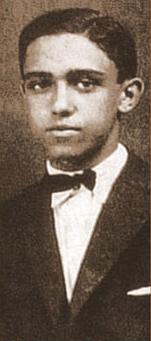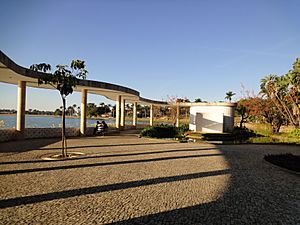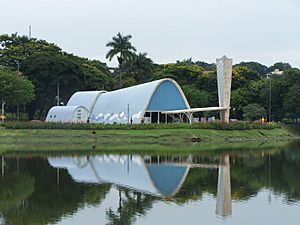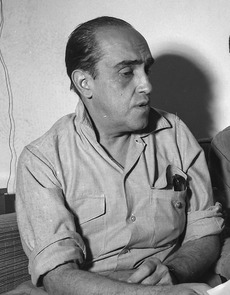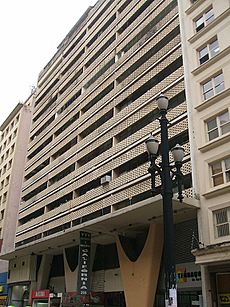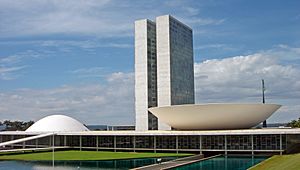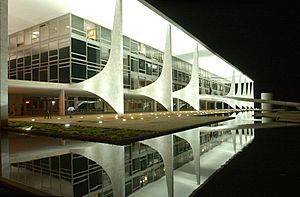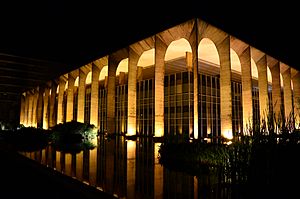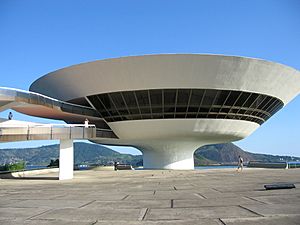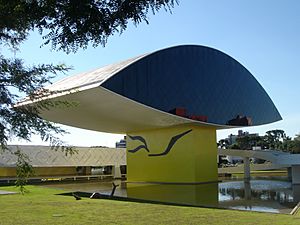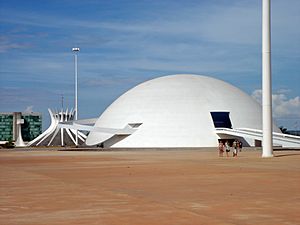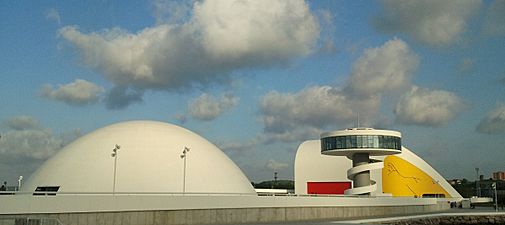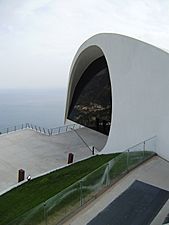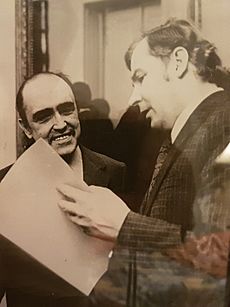Oscar Niemeyer facts for kids
Quick facts for kids
Oscar Niemeyer
|
|
|---|---|

Niemeyer in 1968
|
|
| Born |
Oscar Ribeiro de Almeida Niemeyer Soares Filho
15 December 1907 Rio de Janeiro, Brazil
|
| Died | 5 December 2012 (aged 104) Rio de Janeiro, Brazil
|
| Resting place | São João Batista Cemetery, Rio de Janeiro, Brazil |
| Alma mater |
|
| Occupation | Architect |
| Spouse(s) |
|
| Children | Anna Maria |
| Awards |
|
| Buildings |
|
| Projects | Museum of Modern Art in Caracas |
| Signature | |
Oscar Ribeiro de Almeida Niemeyer Soares Filho (born December 15, 1907 – died December 5, 2012), known as Oscar Niemeyer, was a famous Brazilian architect. He is considered one of the most important people in the history of modern architecture.
Niemeyer was best known for designing many important public buildings in Brasília. This was a planned city that became Brazil's capital in 1960. He also helped design the United Nations Headquarters in New York. His unique way of using reinforced concrete to create curved shapes was very influential.
People admired Niemeyer as a great artist and one of the best architects of his time. He said his work was inspired by Le Corbusier, another famous architect. But Niemeyer also made sure his own style was different and unique.
He studied at the Escola Nacional de Belas Artes in Rio de Janeiro. After graduating, he worked for his father and as a draftsman for other architecture firms. In the 1930s, he worked with Lúcio Costa. They designed the Gustavo Capanema Palace together.
Niemeyer's first big project was a group of buildings for Pampulha. This was a planned area near Belo Horizonte. His work there, especially the Church of Saint Francis of Assisi, became very famous. It brought him international attention. Throughout the 1940s and 1950s, Niemeyer became one of Brazil's busiest architects. He worked on projects both in Brazil and other countries. This included the Edifício Copan in São Paulo and his work on the United Nations Headquarters.
In 1956, Brazil's new president, Juscelino Kubitschek, asked Niemeyer to design the main buildings for Brazil's new capital, Brasília. His designs for buildings like the National Congress of Brazil and the Cathedral of Brasília were very new and exciting. They all shared similar design ideas.
Because of his political beliefs, Niemeyer left Brazil after a military coup in 1964. He opened an office in Paris. He returned to Brazil in 1985 and won the important Pritzker Architecture Prize in 1988. Niemeyer continued working into his late 90s and early 100s. He designed about 600 projects in his 78-year career. He passed away in Rio de Janeiro on December 5, 2012, at 104 years old.
Biography
Early Life and Education
Oscar Niemeyer was born in Rio de Janeiro, Brazil, on December 15, 1907. His family had roots in Portugal and Germany. He once said that his foreign last name, Niemeyer, became the one he was known by.
As a young person, he enjoyed life in Rio. In 1928, at age 21, he married Annita Baldo. She was the daughter of Italian immigrants.
He loved art and studied architecture at the National School of Fine Arts in Rio de Janeiro. He earned his architecture degree in 1934.
Starting His Career
After finishing school, Niemeyer worked at his father's printing business. Even though he didn't have much money, he really wanted to work in architecture. He joined the studio of Lúcio Costa and others as a draftsman. He was very good at drawing.
Working with Lúcio Costa was very important for Niemeyer. Costa believed that the new "International Style" of architecture from Europe was the future. He also thought Brazilian architecture could mix old colonial styles with modern ideas.
In 1936, when Niemeyer was 29, Lúcio Costa was asked to design a new government building in Rio. Costa invited Le Corbusier, a famous Swiss architect, to be a consultant. Niemeyer insisted on joining the team. He helped Le Corbusier with his drawings. After Le Corbusier left, Niemeyer made some big changes to the plans. Costa was so impressed that he let Niemeyer take charge of the project in 1939.
Brazilian Modern Architecture
The building for the Ministry of Education and Health was finished in 1943. Niemeyer was 36 years old. This was the world's first government-sponsored modern skyscraper. It was much bigger than anything Le Corbusier had built before.
This building helped define what became known as "Brazilian modernism." It used local materials and techniques. These included azulejos (colorful tiles) from Portuguese traditions. It also had adjustable sun shades inspired by old colonial designs. The building featured bright colors and tropical gardens designed by Roberto Burle Marx. This building is seen by many as one of the most important of the 20th century.
New York World's Fair
In 1939, Niemeyer and Costa designed the Brazilian pavilion for the New York World's Fair. Niemeyer was 32. Their building was light and elegant, with curved shapes. It was very different from the heavier French pavilion next door. The mayor of New York, Fiorello La Guardia, was so impressed that he gave Niemeyer the keys to the city.
Niemeyer said his true architectural journey began in Pampulha. He explained that Pampulha was the start of his "freer architecture full of curves," which he loved. He said, "It was in fact, the beginning of Brasília..."
The Pampulha Project
In 1940, Niemeyer met Juscelino Kubitschek, who was the mayor of Belo Horizonte. Kubitschek wanted to build a new area called Pampulha. He asked Niemeyer to design a group of buildings there. This became known as the "Pampulha architectural complex."
The complex included a casino, a restaurant, a yacht club, a golf club, and a church. All these buildings were placed around a new artificial lake. A house for the mayor was also built nearby.
The buildings were finished in 1943. They became famous after an exhibition called 'Brazil Builds' at the New York Museum of Modern Art (MoMA). Niemeyer's designs showed his unique way of using Le Corbusier's ideas. For example, in the casino, he used curved shapes even though the main front of the building was straight.
The small restaurant, called Casa do Baile, was built on its own island. It had a round shape with a free-form canopy that followed the island's edge. This use of free-form shapes, along with the butterfly roof on the Yacht Club, became very popular.
The Church of Saint Francis of Assisi is considered the most important building in the complex. Niemeyer used reinforced concrete in a new and exciting way. He made the walls and roof into one flowing element. This was a revolutionary idea. The church was also decorated with beautiful tiles and murals by Brazilian artists.
Because of its importance, the church was the first modern building in Brazil to be officially protected. However, local church leaders refused to consecrate it until 1959. This was partly because of its unusual shape and a mural that showed Saint Francis helping sinners.
Niemeyer said that Pampulha allowed him to "challenge the boring look of modern architecture." He wanted to use the freedom that reinforced concrete offered. He loved curves, like those found in old baroque churches. He wanted to create buildings that were inspired by Brazil's beautiful beaches, mountains, and people.
This project also marked the start of Niemeyer's work with Roberto Burle Marx. Marx was a very important landscape architect. They worked together on many projects for the next 10 years.
1940s and 1950s

After the success of Pampulha and the 'Brazil Builds' exhibition, Niemeyer became known worldwide. His architecture helped develop a unique "Brazilian style." His buildings showed how he could solve difficult problems with simple and clever designs.
In 1947, Niemeyer went to New York City to join an international team. They were designing the United Nations Headquarters. Niemeyer's design was initially chosen. But he eventually worked with Le Corbusier to combine their ideas.
Tremaine House (Unbuilt)
While in the United States, Niemeyer also worked on plans for the Burton G. Tremaine house. This was one of his most daring house designs, meant to be built in California. It had an open layout and gardens by Roberto Burle Marx.
Niemeyer designed very few buildings in the United States. This was because his connection to the Brazilian Communist Party often prevented him from getting a visa. For example, in 1946, he was invited to teach at Yale University, but his political views stopped him. In 1953, at 46, he was asked to be the dean of the Harvard Graduate School of Design. Again, the U.S. government denied his visa.
In 1950, the first book about his work was published in the United States. It helped more people around the world learn about his architecture. By this time, Niemeyer was confident in his own unique style.
Niemeyer's creative designs have been compared to those of sculptors. In the 1950s, Brazil was building a lot, and Niemeyer received many requests for designs. In 1950, he was asked to design Ibirapuera Park in São Paulo. This was for the city's 400th anniversary. The original plan was very grand, but it had to be made simpler due to costs.
Niemeyer also designed special V-shaped columns, called pilotis, for this project. These became very popular for a while. A similar idea was used for the Governador Juscelino Kubitschek housing complex in 1951. This had two large buildings with about 1,000 apartments.

A similar large apartment building, the Edifício Copan (1953–66), was built in the center of São Paulo. This famous building is like a small city itself, with many different kinds of people living there. Its long, horizontal shape and concrete sun shades made it an interesting idea for city housing.
In 1954, Niemeyer also designed the "Niemeyer apartment building" in Belo Horizonte. Its completely free-form shape was very modern. Also in 1954, he built a public library as part of the same plaza.
During this time, Niemeyer designed several homes. His most famous house design is the 1953 Canoas House, which he built for himself. The house is on a sloping hill with a view of the ocean. It has two floors. The top floor is under a free-form roof supported by thin metal columns. The design fits perfectly with the natural landscape.
Changing His Style
In 1953, some critics started to question modern Brazilian architecture. They especially criticized Niemeyer's use of free-form shapes as being just for decoration.
Niemeyer first disagreed with these criticisms. He argued that critics didn't understand the different social and economic situations in Brazil. However, he later realized that some less talented architects were copying his style in a bad way.
In 1957, Niemeyer visited Europe for the first time. Seeing the old monuments there had a big impact on him. He began to believe that a building's beauty was its most important quality. This trip, along with his thoughts on how Brazilian architecture was being copied poorly, led him to change his approach.
He decided to simplify his designs. He wanted his architecture to be a pure expression of its structure. For him, "when form creates beauty, it has in beauty itself its justification."
In 1955, Niemeyer designed the Museum of Modern Art in Caracas. This museum showed his new, simpler style. It was shaped like an upside-down pyramid and stood out dramatically from its surroundings. The building had almost no windows on its walls, but a glass ceiling let in natural light.
This simpler, more aesthetic style reached its peak in his work in Brasília. There, the beauty of the buildings came from their structural elements alone.
Designing Brasília
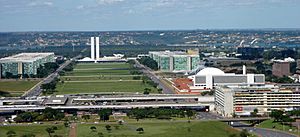
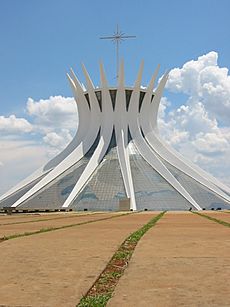
In September 1956, Brazil's new president, Juscelino Kubitschek, visited Niemeyer. He told the architect his big plan: "I am going to build a new capital for this country and I want you to help me."
Niemeyer organized a competition for the city's layout. His old friend and teacher, Lúcio Costa, won. Niemeyer would design the buildings, and Costa would design the city's overall plan.
In just a few months, Niemeyer designed many important buildings. These included the President's home (Palácio da Alvorada), the National Congress of Brazil, the Cathedral of Brasília, and various government ministries. From above, you can see that the city's buildings share similar shapes, creating a unified look.
Building Brasília was a huge effort. It was built in the middle of the country, far from any major cities. President Kubitschek wanted to boost industry, connect distant parts of the country, and bring progress to a remote area. Niemeyer and Costa used this project to try out new ideas for city planning. They designed streets without traffic lights and buildings raised on columns, allowing open space underneath.
The project also had a social idea: in Brasília, all apartments would be owned by the government. They would be rented to employees. This meant that top government officials and regular workers would live in the same buildings. Many of these ideas were later changed by other presidents. Brasília was designed, built, and opened in just four years.
After Brasília was finished, Niemeyer became the head of the architecture college at the University of Brasília. In 1963, he became an honorary member of the American Institute of Architects. That same year, he received the Lenin Peace Prize from the Soviet Union.
Niemeyer and his work on Brasília were even shown in the 1964 French movie L'homme de Rio.
In 1964, when Niemeyer was 57, he returned to a very different Brazil. The president, João Goulart, was removed from power by a military coup. Brazil became a dictatorship until 1985.
In 1987, Brasília was named a World Heritage Site by UNESCO. Niemeyer was the first person to receive this honor for one of his works while still alive.
Living Abroad and International Projects
Niemeyer's political views caused him problems during the military dictatorship. His office was searched, and he lost clients. In 1965, he and 200 other professors resigned from the University of Brasília to protest the government. That same year, he traveled to France for an exhibition.
The next year, Niemeyer moved to Paris. He opened an office there and found clients in many countries. He designed the University of Science and Technology-Houari Boumediene in Algeria. In Paris, he created the Headquarters of the French Communist Party. He also designed a casino in Funchal on Madeira.
While in Paris, Niemeyer also started designing furniture. His chairs and other pieces often had curves that reminded people of the beautiful hills and female forms in Brazil.
Later Life and Passing
The military dictatorship in Brazil ended in 1985. Niemeyer then returned to his home country. In the 1980s, he designed the Memorial Juscelino Kubitschek (1980) and the Latin America Memorial (1987). The memorial sculpture for Latin America shows a wounded hand, with the wound bleeding in the shape of Central and South America.
In 1988, at 81, Niemeyer received the Pritzker Architecture Prize. This is one of the most important awards in architecture. From 1992 to 1996, Niemeyer was the president of the Brazilian Communist Party. Even though he wasn't very active in politics, his fame helped the party survive.
He continued to design buildings into his 90s. In 1996, at 89, he designed the Niterói Contemporary Art Museum. This building hangs out from a rock face, offering amazing views of Guanabara Bay and Rio de Janeiro.
Niemeyer kept his studio in Rio de Janeiro open even in the 21st century. In 2002, the Oscar Niemeyer Museum opened in Curitiba, Brazil. In 2003, at 96, he was asked to design the Serpentine Gallery Summer Pavilion in London. This gallery invites a famous architect who has never built in the UK to design a temporary structure each year.
He was still working on projects at 100 years old. On his 100th birthday, Russia's president, Vladimir Putin, gave him the Order of Friendship.
In 2011, the Oscar Niemeyer International Cultural Centre opened in Spain. Niemeyer had donated the design for this cultural center. In January 2010, the Auditorium Oscar Niemeyer Ravello officially opened in Ravello, Italy.
After turning 100, Niemeyer was often in the hospital. His daughter, Anna Maria, passed away in June 2012 at age 82. Oscar Niemeyer passed away on December 5, 2012, in Rio de Janeiro, at the age of 104. He had been in the hospital for a respiratory infection.
The BBC said that Niemeyer "built some of the world's most striking buildings." They described him as "one of the most innovative and daring architects of the last 60 years."
-
Oscar Niemeyer Museum (NovoMuseu), Curitiba, Brazil
-
Brazilian National Museum, Brasília, Brazil
-
Natal City Park Tower, Natal, Brazil
Personal Life
Niemeyer married Annita Baldo in 1928. They had one daughter, Anna Maria, in 1929. Anna Maria passed away before her father in 2012. Niemeyer also had many grandchildren and great-grandchildren. Annita passed away in 2004, at 93, after 76 years of marriage.
In 2006, just before his 99th birthday, Niemeyer married for a second time. He married his longtime secretary, Vera Lucia Cabreira.
Political and Religious Views
Niemeyer had strong left-wing political beliefs. In 1945, he helped some communist activists who had been released from prison. He met Luís Carlos Prestes, a very important left-wing leader in Brazil. Niemeyer joined the Communist Party in 1945 and later became its president in 1992.
During Brazil's military dictatorship, his office was raided. He was forced to live in Europe for a time. He visited the Soviet Union and met with some of its leaders. In 1963, he received the Lenin Peace Prize. Niemeyer was also a close friend of Fidel Castro, the leader of Cuba. Castro once said, "Niemeyer and I are the last communists on this planet."

Some people pointed out that Niemeyer's architecture sometimes seemed to go against his political views. For example, his first major work, the Church of Saint Francis of Assisi, was seen as having a "fancy" style. Brasília was also famous for its grand palaces.
Niemeyer believed that architecture alone couldn't change an "unfair society." He thought that such changes should happen through political action. He said, "Our concern is political too – to change the world... Architecture is my work... but life is more important than architecture. What matters is to improve human beings."
Niemeyer was an atheist his whole life. He based his beliefs on the "injustices of this world" and on the vastness of the universe. He once said, "It's a fantastic Universe which humiliates us... But we are amazed by the power of the human mind."
Even though he was an atheist, he designed many religious buildings. These included Catholic chapels, Orthodox churches, and mosques. He wanted his religious buildings to connect people to their spiritual beliefs. For example, in the Cathedral of Brasília, he wanted the large glass windows "to connect the people to the sky, where their Lord's paradise is."
Criticism
Nicolai Ouroussoff, an architecture critic for The New York Times, wrote an article questioning if Niemeyer's later work was affected by his old age. Ouroussoff felt that the "Niterói Contemporary Art Museum" was not as good as Niemeyer's earlier works. He suggested that the biggest threat to Niemeyer's amazing legacy might be Niemeyer himself in his later years.
Legacy
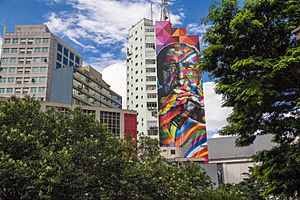
Since 1984, the Rio de Janeiro carnival parade has been held in the Sambadrome Marquês de Sapucaí, which Oscar Niemeyer designed. In 2003, a samba school celebrated Niemeyer's life in their carnival parade. It was the first time they honored a living historical figure.
Oscar Niemeyer's designs have also inspired artists. In 2006, French painter Jacques Benoit showed paintings called Three Traces of Oscar. These honored Niemeyer's work in France. In 2010, Benoit's works were shown in an exhibition celebrating Brasília's 50th anniversary.
Shortly before Niemeyer passed away in 2012, artist Sarah Morris filmed him in his office for her film Rio.
In 2013, after Niemeyer's death, Brazilian street artist Eduardo Kobra and other painters created a huge mural. It covered the side of a skyscraper in São Paulo. The artwork was inspired by Niemeyer's architecture and his love for concrete.
Niemeyer also appeared in the film Urbanized. In it, he talked about how he designed buildings and his ideas about architecture.
Decorations and Awards
- Member of the American Academy of Arts and Sciences (1949)
- Medal of the Order of Merit of Labour (Brazil, 1959)
- International Lenin Peace Prize (1963)
- Golden Lion of the Venice Biennale (Italy, 1963)
- Honorary Member of the American Institute of Architects (1963)
- Honorary Member of the National Institute of Arts and Letters (USA, 1964)
- Premio Benito Juarez (1964)
- Médaille Joliot-Curie (1965)
- Knight of the Legion of Honour (France, 1970)
- Commander of the Order of Prince Henry (Portugal, March 3, 1975)
- Lorenzo il Magnifico Prize (Italy, 1980)
- Commander of the Order of Arts and Letters (France, 1982)
- Honorary Member of the Academy of Arts of the USSR (1983)
- Pritzker Architecture Prize (1988)
- Prince of Asturias Award (1989)
- Honorary Doctor of the University of Brasília (1989)
- Chico Mendes Resistance Medal (1989)
- Gold Medal of the Colegio de Arquitectos de Barcelona (1990)
- Knight Commander of the Order of St. Gregory the Great (1990)
- Grand Cross of the Order of Saint James of the Sword (Portugal, November 26, 1994)
- Honorary doctorate from the University of São Paulo (1995)
- Doctor Honoris Causa from the Federal University of Minas Gerais (1995)
- Saurí Order, 1st class (Dominican Republic, 1996)
- Golden Lion at the Venice Biennale (Italy, 1996)
- Royal Gold Medal of the Royal Institute of British Architects (1998)
- Order of Solidarity (Cuba, 2001)
- Darcy Ribeiro Medal of Merit (Brazil, 2001)
- Unesco Award in the category of Culture (2001)
- Grand Officer of the Order of Merit Teaching and Cultural Gabriela Mistral (Chile, 2001)
- "20th century architect" (Brazil, 2001)
- Konex Award (Argentina, 2002)
- Praemium Imperiale (Japan, 2004)
- Austrian Decoration for Science and Art (2005)
- Patron of Brazilian architecture (2005)
- Order of Cultural Merit (Brazil, 2007)
- Commander of the Legion of Honour (France, 2007)
- Order of Friendship (Russia, 2007)
- Medal Oscar Niemeyer's Communist Party Marxist-Leninist (2007)
- ALBA Arts Award (Venezuela, 2008)
- Order of Arts and Letters of Spain (November 6, 2009)
- Doctor Honoris Causa of the Technical University of Lisbon (2009)
See also
 In Spanish: Oscar Niemeyer para niños
In Spanish: Oscar Niemeyer para niños
- List of Oscar Niemeyer works


